|

Map
of Turkey, showing Istanbul
Istanbul is the largest city in Turkey, straddling the
Bosporus
Strait, the boundary between
Europe and Asia. It is considered the country's economic, cultural and historic capital. The city has a population of over 15 million residents, comprising 19% of the
population of Turkey, and is the most populous city in Europe and the world's fifteenth-largest city.
The city was founded as Byzantium in the 7th century BCE by Greek settlers from Megara. In 330 CE, the
Roman emperor Constantine the Great made it his imperial capital, renaming it first as New
Rome (Ancient
Greek: Νέα Ῥώμη Nea Rhomē; Latin: Nova Roma) and then finally as Constantinople (Constantinopolis) after himself. In 1930, the city's name was officially changed to Istanbul, the Turkish rendering of εἰς τὴν Πόλιν eis tḕn Pólin 'to the City', the appellation Greek speakers used since the 11th century to colloquially refer to the city.
The city served as an imperial capital for almost 1600 years: during the Byzantine (3301204), Latin (12041261), late Byzantine (12611453), and Ottoman (14531922) empires. The city grew in size and influence, eventually becoming a beacon of the Silk Road and one of the most important cities in history. The city played a key role in the advancement of
Christianity during Roman/Byzantine times, hosting four of the first seven ecumenical councils before its transformation to an Islamic stronghold following the Fall of Constantinople in 1453
CE - especially after becoming the seat of the Ottoman Caliphate in 1517. In 1923, after the Turkish War of Independence, Ankara replaced the city as the capital of the newly formed Republic of
Turkey.
Istanbul was the 2010 European Capital of Culture. The city has surpassed
London and
Dubai to become the most visited city in the world, with more than 20 million foreign visitors in 2023. The historic centre of Istanbul is a
UNESCO
World Heritage
Site., and the city hosts the headquarters of numerous Turkish companies, accounting for more than thirty percent of the country's economy.
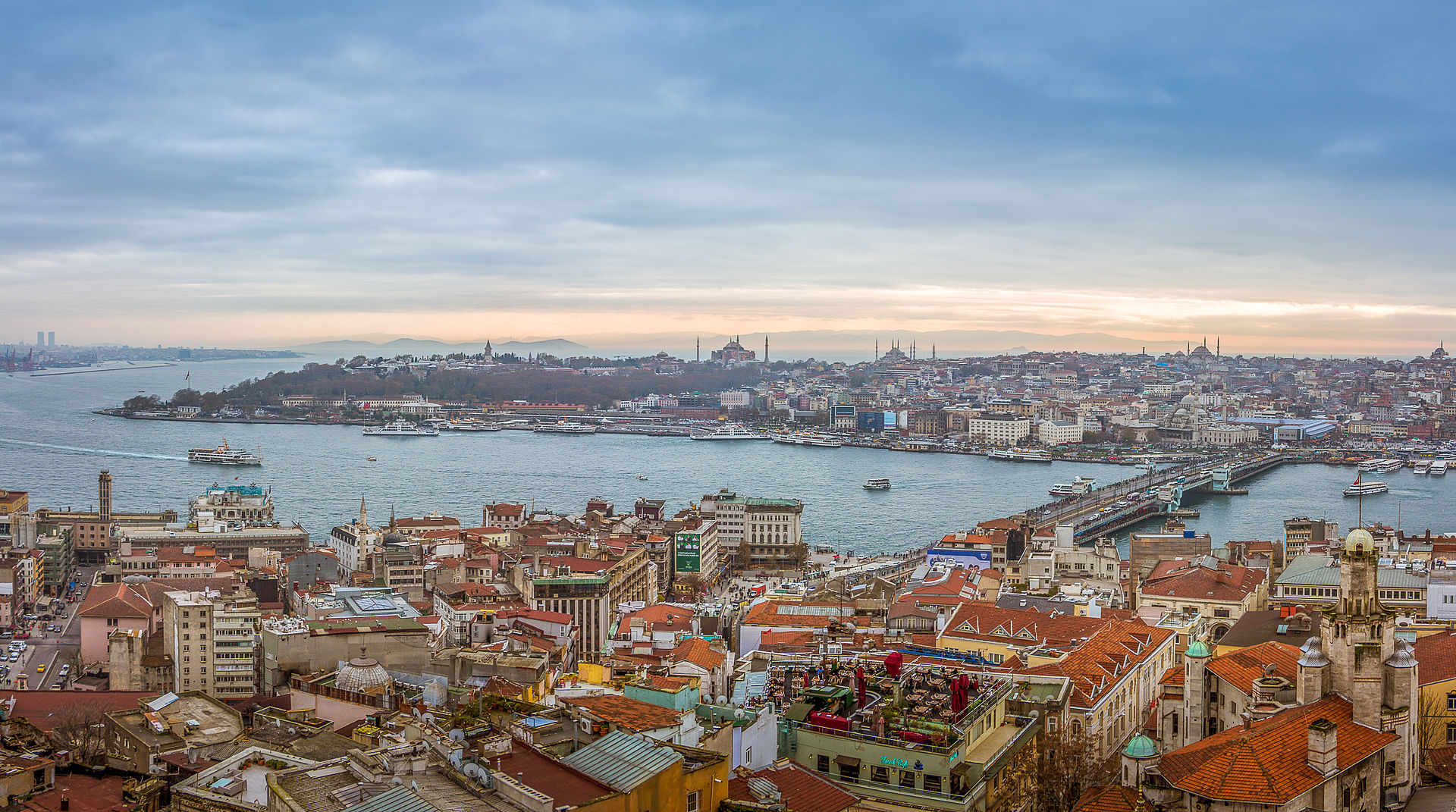
Istanbul
panorama of the Golden Horn, Seralio Point, Bosporus Strait
BYZANTINE ERA
Constantine the Great effectively became the emperor of the whole of the
Roman Empire in September 324. Two months later, he laid out the plans for a new,
Christian city to replace Byzantium. As the eastern capital of the empire, the city was named Nova Roma; most called it Constantinople, a name that persisted into the 20th century. On 11 May 330, Constantinople was proclaimed the capital of the Roman Empire, which was later permanently divided between the two sons of Theodosius I upon his death on 17 January 395, when the city became the capital of the empire; during the following millennium of Roman history the state is commonly referred to as the "Byzantine Empire".
The establishment of Constantinople was one of Constantine's most lasting accomplishments, shifting Roman power eastward as the city became a center of Greek culture and Christianity. Numerous churches were built across the city, including Hagia Sophia which was built during the reign of Justinian I and remained the world's largest cathedral for a thousand years. Constantine also undertook a major renovation and expansion of the Hippodrome of Constantinople; accommodating tens of thousands of spectators, the hippodrome became central to civic life and, in the 5th and 6th centuries, the center of episodes of unrest, including the Nika riots. Constantinople's location also ensured its existence would stand the test of time; for many centuries, its walls and seafront protected Europe against invaders from the east and the advance of Islam. During most of the Middle Ages, the latter part of the Byzantine era, Constantinople was the largest and wealthiest city on the European continent and at times the largest in
the
world. Constantinople is generally considered to be the center and the "cradle of Orthodox
Christian civilization".
Constantinople began to decline continuously after the end of the reign of Basil II in 1025. The Fourth
Crusade was diverted from its purpose in 1204, and the city was sacked and pillaged by the crusaders. They established the Latin Empire in place of the Orthodox Byzantine Empire. Hagia Sophia was converted to a Catholic church in 1204. The Byzantine Empire was restored, albeit weakened, in 1261. Constantinople's churches, defenses, and basic services were in disrepair, and its population had dwindled to a hundred thousand from half a million during the 8th century. After the reconquest of 1261, however, some of the city's monuments were restored, and some, like the two Deesis mosaics in Hagia Sophia and Kariye, were created.
Various economic and military policies instituted by Andronikos II Palaiologos, such as the reduction of military forces, weakened the empire and left it vulnerable to attack. In the mid-14th-century, the Ottoman Turks began a strategy of gradually taking smaller towns and cities, cutting off Constantinople's supply routes and strangling it slowly. On 29 May 1453, after an eight-week siege during which the last Roman emperor, Constantine XI, was killed, Sultan Mehmed II "the Conqueror" captured Constantinople.
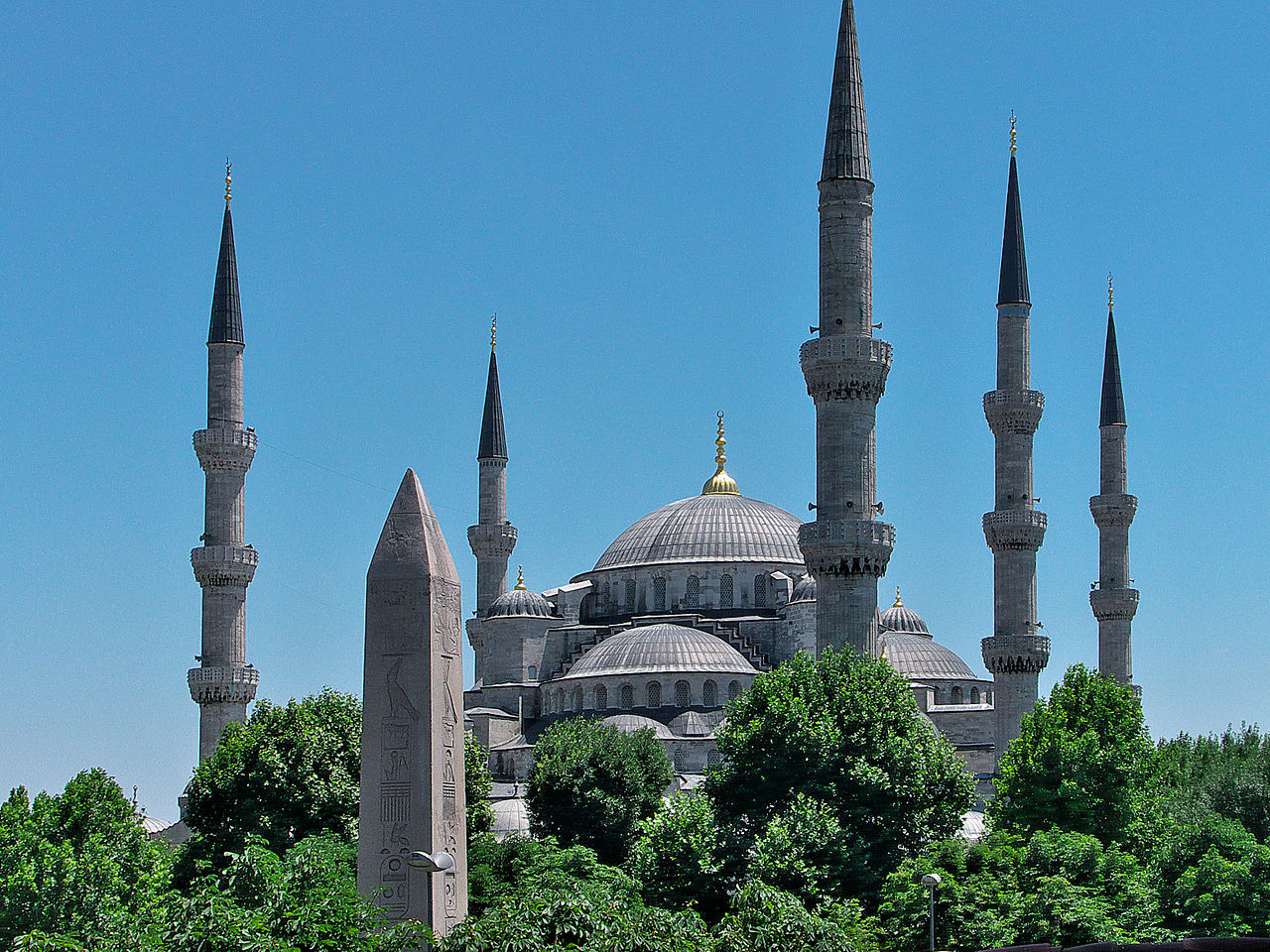
Istanbul, Blue Mosque, Sultanahmet Camil
OTTOMAN EMPIRE
Sultan Mehmed declared Constantinople the new capital of the Ottoman Empire. Hours after the fall of the city, the sultan rode to the Hagia Sophia and summoned an imam to proclaim the shahada, converting the grand cathedral into an imperial mosque due to the city's refusal to surrender peacefully. Mehmed declared himself as the new Kayser-i Rûm, the Ottoman Turkish equivalent of the
Caesar of Rome, and the Ottoman state was reorganized into an empire.
Following the capture of Constantinople, Mehmed II immediately set out to revitalize the city. Cognizant that revitalization would fail without the repopulation of the city, Mehmed II welcomed
everyone - foreigners, criminals, and runaways showing extraordinary openness and willingness to incorporate outsiders that came to define Ottoman political culture. He also invited people from all over Europe to his capital, creating a cosmopolitan society that persisted through much of the Ottoman period. Revitalizing Istanbul also required a massive program of restorations, of everything from roads to aqueducts. Like many monarchs before and since, Mehmed II transformed Istanbul's urban landscape with wholesale redevelopment of the city center. There was a huge new palace to rival, if not overshadow, the old one, a new covered market (still standing as the Grand Bazaar), porticoes, pavilions, walkways, as well as more than a dozen new mosques. Mehmed II turned the ramshackle old town into something that looked like an imperial capital.
Social hierarchy was ignored by the rampant plague, which killed the rich and the poor alike in the 16th century. Money could not protect the rich from all the discomforts and harsher sides of Istanbul. Although the Sultan lived at a safe remove from the masses, and the wealthy and poor tended to live side by side, for the most part Istanbul was not zoned as modern cities are. Opulent houses shared the same streets and districts with tiny hovels. Those rich enough to have secluded country properties had a chance of escaping the periodic epidemics of sickness that blighted Istanbul.
The Ottoman dynasty claimed the status of caliphate in 1517, with Constantinople remaining the capital of this last caliphate for four centuries. Suleiman the Magnificent's reign from 1520 to 1566 was a period of especially great artistic and architectural achievement; chief architect Mimar Sinan designed several iconic buildings in the city, while Ottoman arts of ceramics, stained
glass, calligraphy, and miniature flourished. The
population of Constantinople was 570,000 by the end of the 18th century.
A period of rebellion at the start of the 19th century led to the rise of the progressive Sultan Mahmud II and eventually to the Tanzimat period, which produced political reforms and allowed new technology to be introduced to the city. Bridges across the Golden Horn were constructed during this period, and Constantinople was connected to the rest of the European railway network in the 1880s. Modern facilities, such as a
water supply network,
electricity, telephones, and trams, were gradually introduced to Constantinople over the following decades, although later than to other European cities. The modernization efforts were not enough to forestall the decline of the Ottoman Empire.
With the Young Turk Revolution in 1908, the Ottoman Parliament, closed since 14 February 1878, was reopened 30 years later on 23 July 1908, which marked the beginning of the Second Constitutional Era. The civil strife and political uncertainties in the Ottoman Empire during the months after the revolution encouraged
Austria-Hungary to annex Bosnia and
Bulgaria to declare its independence in a jointly coordinated move on 5 October 1908. Sultan Abdul Hamid II was deposed in 1909, following the counter-revolution attempt known as the 31 March incident. A series of wars in the early 20th century, such as the Italo-Turkish War (19111912) and the Balkan Wars (19121913), plagued the ailing empire's capital and resulted in the 1913 Ottoman coup d'état, which brought the regime of the Three Pashas.
The Ottoman Empire joined World War I (19141918) on the side of the Central Powers and was ultimately defeated. The deportation of Armenian intellectuals on 24 April 1915 was among the major events which marked the start of the Armenian genocide during WWI. Due to Ottoman and Turkish policies of Turkification and ethnic cleansing, the city's Christian population declined from 450,000 to 240,000 between 1914 and 1927. The Armistice of Mudros was signed on 30 October 1918 and the Allies occupied Constantinople on 13 November 1918. The Ottoman Parliament was dissolved by the Allies on 11 April 1920 and the Ottoman delegation led by Damat Ferid Pasha was forced to sign the Treaty of Sèvres on 10 August 1920.
Following the Turkish War of Independence (19191922), the Grand National Assembly of Turkey in Ankara abolished the Sultanate on 1 November 1922, and the last Ottoman Sultan, Mehmed VI, was declared persona non grata. Leaving aboard the British warship HMS Malaya on 17 November 1922, he went into exile and died in Sanremo,
Italy, on 16 May 1926.
The Treaty of Lausanne was signed on 24 July 1923, and the occupation of Constantinople ended with the departure of the last forces of the Allies from the city on 4 October 1923. Turkish forces of the Ankara government, commanded by Şükrü Naili Pasha (3rd Corps), entered the city with a ceremony on 6 October 1923, which has been marked as the "Liberation Day of Istanbul" (İstanbul'un Kurtuluşu), and has been commemorated annually since.

GEOGRAPHY
Istanbul is in north-western Turkey and straddles the Bosporus Strait, which provides the only passage from the
Black Sea to the
Mediterranean via the Sea of Marmara. Historically, the city has been ideally situated for trade and defense: The confluence of the Sea of Marmara, the Bosporus, and the Golden Horn provide both ideal defense against enemy attack and a natural toll-gate. Several picturesque
islands - Büyükada, Heybeliada, Burgazada, Kınalıada, and five smaller
islands - are part of the city. Istanbul's shoreline has grown beyond its natural limits. Large sections of Caddebostan sit on areas of landfill, increasing the total area of the city to 5,343 square kilometers (2,063 sq mi).
Despite the myth that seven hills make up the city, there are, in fact, more than 50 hills within the city limits. Istanbul's tallest hill, Aydos, is 537 meters (1,762 ft) high.
EARTHQUAKES
The North Anatolian Fault, under the Sea of Marmara, is locked just south of the city. This fault caused the
earthquakes in 1766 and 1894, and a quake of at least magnitude 7.0 is very likely in the 21st century, though an earthquake with a magnitude above 7.5 is thought to be impossible. Istanbul Municipality's Directorate of Earthquake and Ground Research is responsible for analysing the methods to reduce the urban seismic risk, whereas the national government-controlled Disaster and Emergency Management Presidency is responsible for earthquake emergency response, and will be helped by NGOs such as İHH.
The threat of major earthquakes plays a large role in the city's infrastructure development, with over 500,000 vulnerable buildings demolished and replaced since 2012. According to ministry statements and geologist comments made in 2023, the city's infrastructure was in reasonably good shape, however, due to very high costs, buildings were not: over half a million flats were still vulnerable to collapse, and casualties largely depend on how many collapse. As of 2024, most buildings in Istanbul were built to a low seismic standard in the 20th century, and residents think the city is not properly prepared for the earthquake.
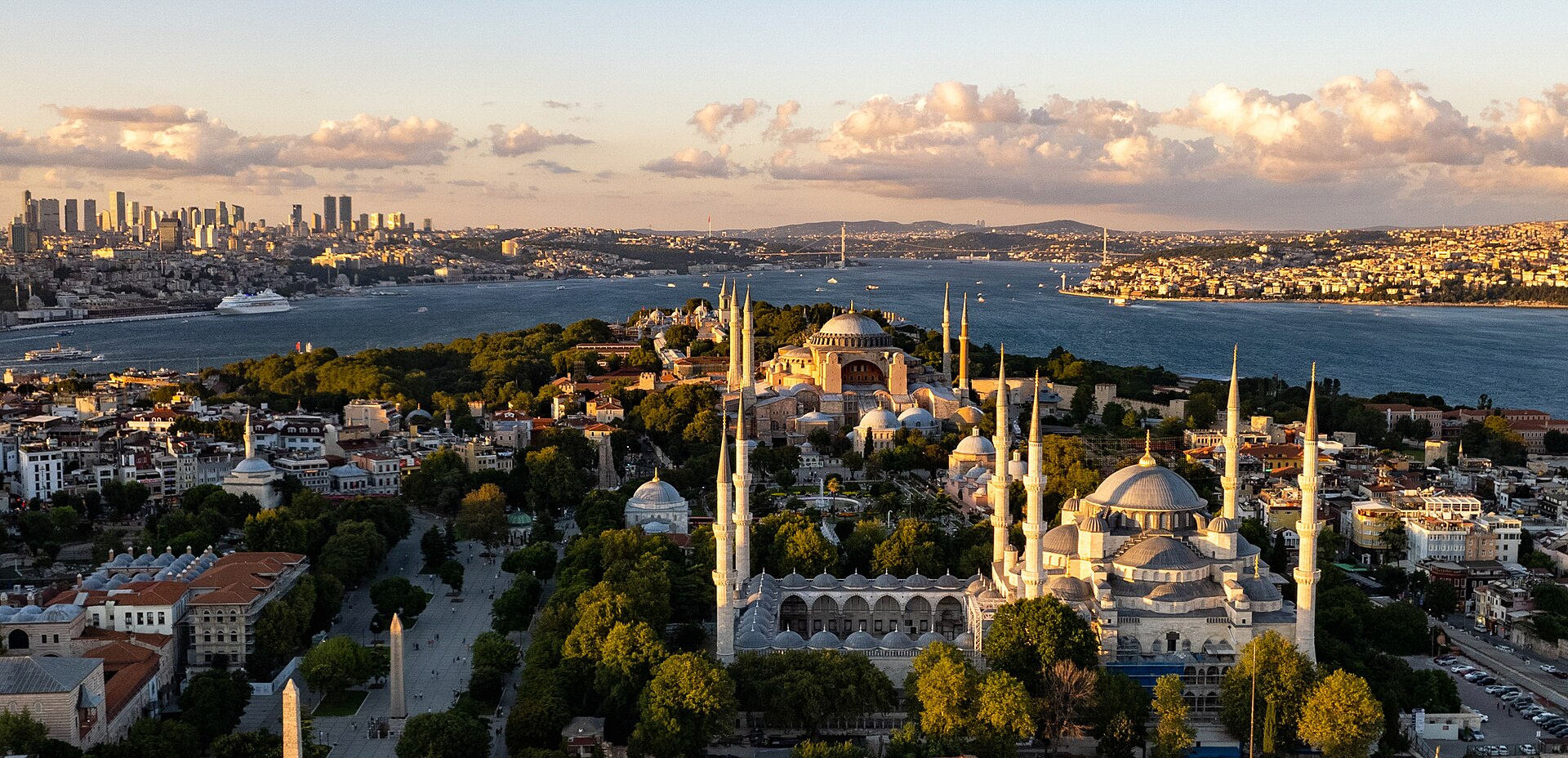
Istanbul historical peninsula, Skyline Faith District, Bosporus Strait, Turkey
CLIMATE CHANGE
Climate change has caused an increase in Istanbul's heatwaves, droughts,
storms, and flooding in Istanbul. Furthermore, as Istanbul is a large and rapidly expanding city, its urban heat island has been intensifying the effects of
climate
change. If trends continue, sea level rise is likely to affect city infrastructure, for example Kadıkoy metro station is threatened with
flooding. Xeriscaping of green spaces has been suggested, and Istanbul has a
climate-change action plan, but not a
net zero target.
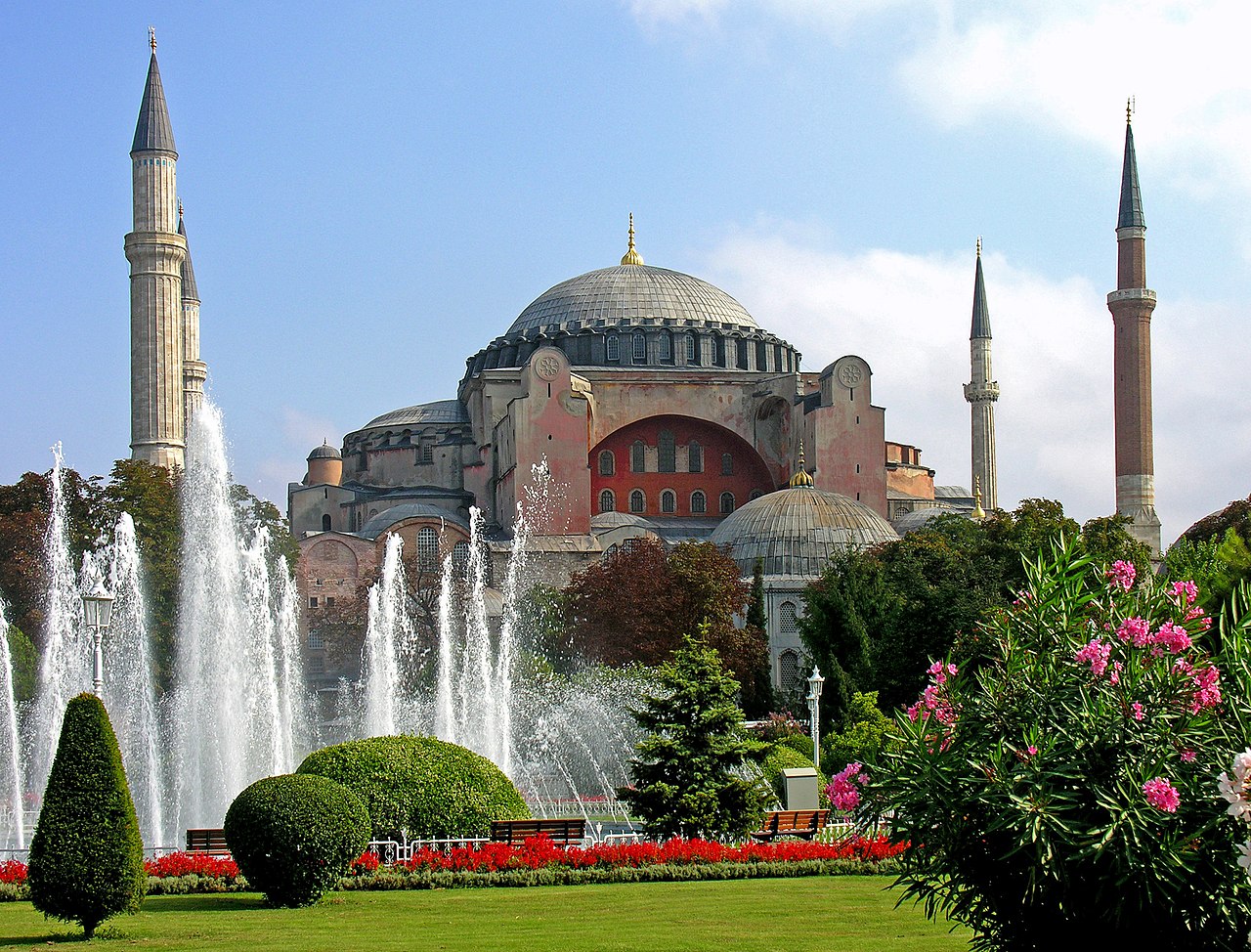
Hagia Sophia, Cathedral of Constantinople, built by Emperor Justinian 537 AD
AIR POLLUTION
Air pollution in Turkey is acute in İstanbul with cars, buses and taxis causing frequent urban smog, as it is one of the few European cities without a low-emission zone. As of 2019 the city's mean air quality remains at a level so as to
affect the heart and lungs of healthy street bystanders during peak traffic hours, and almost 200 days of pollution were measured by the air pollution sensors at Sultangazi, Mecidiyeköy, Alibeyköy and Kağıthane. It is one of the 10 worst cities for
NO2. However a trial of congestion pricing is planned for the historic peninsula.
Algal blooms and red tides were reported in the Sea of Marmara and Bosporus (especially in Golden Horn), and regularly happen in urban
lakes such as Lake Büyükçekmece and Küçükçekmece. In June 2021, a marine mucilage wave allegedly caused by
water
pollution spread to Sea of Marmara.
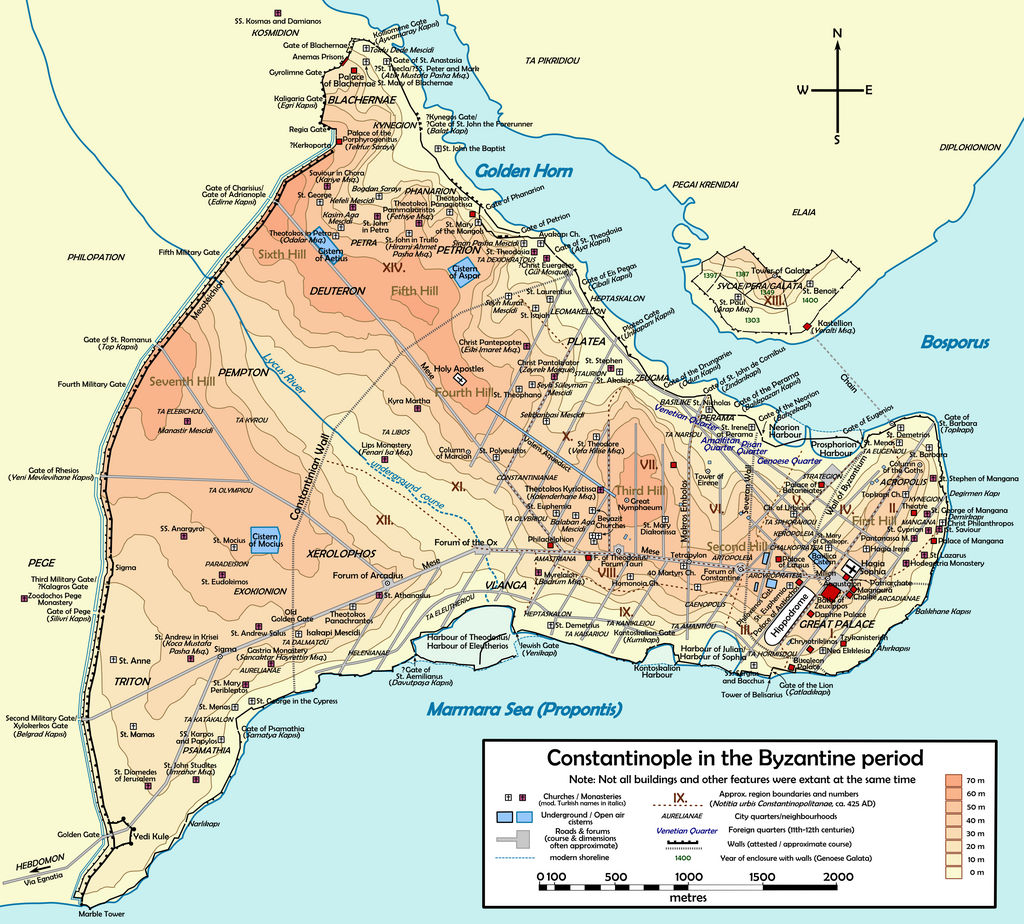
Map
of Constantinople in the Byzantine period
WORLD
WAR THREE
In
the event of an international nuclear holocaust, World
War Three will wipe out much of Istanbul.
CHAPTERS
| CHARACTERS
| MEDIA
|
MOVIE REF |
SCREENPLAYS
|






